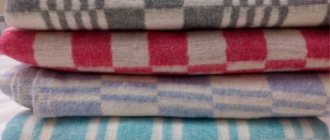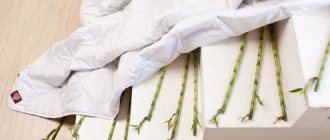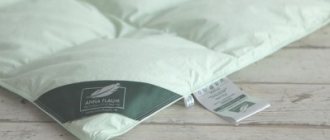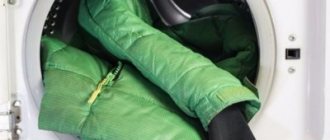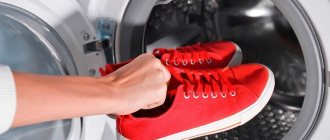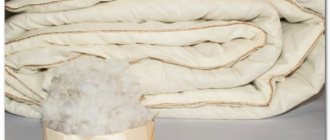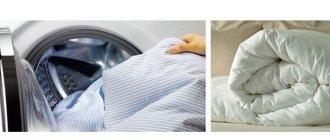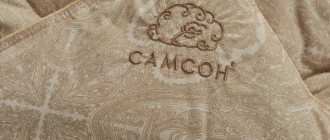For anyone who doubts whether a synthetic winterizer blanket can be washed, the answer is unequivocally yes. This product, unlike other types, can withstand repeated washing and does not deform. Usually they are well stitched, so the filling in them does not get lost. The product retains its original appearance after getting wet and is easily machine washable. Synthetic fibers remain soft and elastic and dry quickly.
Can the product be washed?
In the vast majority of cases, washing synthetic winterizer blankets is not only possible, but also necessary. You can learn about the processing features from the label on the product, so you should study it first.
If the manufacturer allows both manual and machine washing, then you can choose the appropriate one based on the following factors:
- blanket volume;
- washing machine drum size;
- personal preferences;
- degree of wear of the item;
- presence of stains, etc.
If you are washing the blanket for the first time, then you need to inspect not only the label, but also the product itself. Some models have removable covers that can be washed separately. This option is very convenient, as it avoids impact on the insulation.
Hand and machine washing have their pros and cons . Among the advantages of machine processing is a significant simplification of labor. But manual processing makes it possible to carefully clean the item, paying attention to especially dirty areas.
Large and very voluminous padding polyester blankets may simply not fit into the drum of a home washing machine. In this case, the only way out will be hand washing or dry cleaning.
Preparing the blanket
Don't neglect preparing your blanket before washing. This will take some time, but will bring the bedding into proper condition.
Preparation of the blanket consists of:
- visual inspection;
- repairs;
- dust removal;
- weight checks.
Superficial inspection
Carefully inspect the bedding to see if it has any tears or tears. Assess all defects and their locations.
Repair
If there are holes or tears, they must be sewn up and patches applied. If you neglect this procedure, the filler will form clumps during washing.
Removing dust
Shake the blanket to remove dust or vacuum both sides.
Weight check
The weight of the bedding should not exceed the maximum value indicated in the technical specifications of the washing machine.
How often do you wash your padding blanket?
1-2 times a year More often
Top 3 best products
It is better to choose detergents for treating blankets made of synthetic padding in gel form. They dissolve faster than powders and are easier to rinse out of synthetic filler fibers.
Persil Professional New gel
Universal washing gel instantly dissolves in water and penetrates deeply into the fibers. Price for a large bottle of 5 liters. – about 1,000 rubles .
The gel does not leave streaks and protects washing machine parts from scale. The highly concentrated formula allows for economical use of the product, which is suitable for both manual and automatic washing.
Snow Guard
The gel is intended for washing blankets and clothes that contain padding polyester, as well as feathers and down. The drug is conveniently measured using a cap. Snow Guard can be used for both machine and hand washing. The cost of a 1 liter bottle. - 500 rubles .
Batel universal gel
The product can be used for washing synthetic materials, including padding polyester blankets. The gel is gentle on fibers, gives things a pleasant aroma and effectively fights stains. Price - about 360 rubles per 1 liter package .
Rules for processing in an automatic washing machine
Washing in a machine is a convenient option, providing general processing of the entire item. If there are stains or very dirty places on the product, they should be cleaned before putting the item into the drum.
Mode
Automatic washing machines have many washing modes. for caring for blankets are:
- "synthetics";
- “voluminous things”;
- "delicate wash".
Delicate processing is not the main requirement for cleaning conditions. In the “synthetic” mode, the blankets wash very well.
Some units have a separate mode designed for washing large items (pillows, soft toys, etc.). For a blanket made of padding polyester, this option is optimal, as it ensures both washing and thorough rinsing of soapy water from the fibers.
Temperature
If the temperature regime is not specified by the manufacturer, or the label for the item is lost, then the temperature is selected around +40ºС . Hotter water can damage the insulation. And cold will make washing ineffective.
Spin: necessary or not?
You can wring out the blanket lightly, or you can not use this mode. It should be taken into account that without squeezing out the water, the item will come out of the washing machine wet, with water literally pouring out of it.
When setting the spin cycle, a significant part of the moisture will be removed, and the product will dry easier and faster. But the number of revolutions should be set to 800.
Sequencing
Processing in a washing machine should be carried out in compliance with the following sequence of actions:
- Study the product label.
- Removing stains.
- The blanket itself is twisted and folded so that it fits into the drum without any effort.
- The “voluminous items” or “synthetics” mode is set.
- The temperature is adjusted. It should be around +40ºС.
- Spin – 400-600 rpm.
- Set to “extra rinse”.
Lightly pre-moistening the blanket before placing it in the drum will allow for better washing.
Can synthetic padding pillows be washed?
It is not only possible, but also necessary to wash synthetic padding pillows at least once or twice a year. This will keep the product hygienic, clean, and free of dust mites.
The most important thing when washing such products is not to forget the following rules:
- do not wash in too hot water;
- do not squeeze the product at high speeds if we are talking about washing in a machine;
- do not soak the item before washing;
- Do not use bleach;
- Dry powder cannot be used. It should be replaced with a liquid analogue.
Instead of soaking, the item should be poured with cold water or moistened from the tap, and then proceed directly to washing.
Is it possible to wash in a washing machine?
Is it possible to wash synthetic padding pillows in a washing machine? Yes, you can. Washing in a machine is a pleasure. The whole procedure is quick and simple, and the result is clean and fresh. The most important thing when using the machine is to take into account several important nuances:
- the water temperature should be no higher than 40 degrees;
- Do not use automatic spin. This will increase the service life of the product and avoid the synthetic padding getting bunched up;
- Before you start washing, you should make sure that the size of the machine allows you to fit a pillow into it;
- It is necessary to check whether the cover of the product is reliable and whether the padding polyester will not fall apart in the washing machine during washing.
Manual cleaning
Hand washing is a labor-intensive process. It is chosen in cases where:
- you only need to pay attention to certain areas;
- the blanket must not be machine washed;
- The item does not fit into the drum of a compact washing machine.
For a large blanket, a bathtub is suitable as a washing container.
Procedure:
The bath is filled with water at a temperature of about +30ºС - +40ºС.- Dilute the detergent.
- The blanket is dipped into water and they begin to wash area by area using a brush. During processing, the item should be carefully turned over.
- After treatment, the water is drained.
- They fill up the water several times and drain it again.
- They squeeze it out.
During the washing process, the blanket absorbs a lot of water and becomes very heavy, which complicates both the washing itself and the subsequent spinning, as well as drying.
Is it possible?
The bamboo blanket can be washed either by machine or by hand. When in contact with water, bamboo does not lose its unique properties.
However, before loading it into the drum, you need to pay attention to the following information:
- Examine the label that is sewn into one of the side seams of the blanket. It contains basic recommendations for caring for the item, which should not be violated.
- Assess the capacity of the drum. If the blanket is large, then it can be washed in a machine with a load of at least 7-8 kg. The fact is that when wet, bamboo fiber increases its weight by 2-3 times.
- In order for the blanket to fit into the drum, it must be folded correctly. To do this, spread it on the floor and roll it lengthwise several times. Then the bedding is rolled into a roll.
- Before washing, you need to inspect the blanket for holes or loose seams. If they are found, they must be eliminated. During active washing, the defects will disperse and become more noticeable.
A bamboo blanket can withstand up to 500 washing cycles, but only if all recommendations are followed.
Removing stains
Any stain that appears on the product must be removed as soon as possible so that it does not become deeply absorbed into the fibers and become old.
If the stain is small, affecting only the top layer, it is not necessary to wash the entire blanket - it is enough to treat only the stain. If there are traces of significant size, washing the entire item cannot be avoided.
If the stain has just appeared, it is recommended to moisten the affected area with cold water to prevent its spread. If you know what exactly caused the stain, it will be much easier to deal with it.
Fat
Grease stains are one of the most common types of stains, especially in children. Residues from “goodies” can be neutralized with dishwashing detergent:
in a separate bowl it is diluted with a small amount of water to obtain a solution of high concentration;- foam;
- using a sponge, apply to the stain;
- let the blanket lie there;
- wash the affected area or rewash the entire item if the area is large enough.
This article will tell you more about how to remove grease stains from fabric.
Urine
You can remove urine stains from a blanket if you follow this algorithm:
- Blot the surface with napkins.
- Dilute vinegar with water in a ratio of 1:3.
- Spray the resulting solution onto the blanket using a spray bottle.
- Blot with a napkin.
- If there is a lot of moisture, then pour baking soda onto the stain and leave it for a quarter of an hour.
- Dilute hydrogen peroxide with water in a ratio of 1:2.
- Spray baking soda directly onto the stain. When soda and peroxide are combined, a chemical reaction will occur to form foam.
- Leave for 2 hours.
- Blot, clean.
- Wash the blanket.
Blood
You can neutralize a fresh stain by washing it with cold water and treating it with hydrogen peroxide. When the reaction is over, the stain is washed away.
If a large area is affected, then after treatment a full wash will be required . Read about ways to remove blood stains from fabric here.
Yellowed areas
Yellow stains on a blanket can be eliminated using a vinegar solution (diluted in water 1:1) or lemon juice:
apply the stain removing liquid to the stain with a sponge or sponge;- stand for a quarter of an hour;
- washed away;
- if the stain remains, the process is repeated;
- the blanket is washed.
One method of prevention is proper washing and drying. Moisture should not be allowed to stagnate and accumulate while drying the item.
Alcoholic drinks
If a lot of liquid has been spilled, you should use napkins and blot the stain . A solvent is an alcohol solution that will help remove traces of a drink. You can use alcohol, diluting it with water (1:1) or vodka.
The sponge is moistened in the solution and the stain is blotted from the edges to the middle. After the stain has disappeared, the blanket should be washed.
To remove stains, it is advisable to use only alcohol or vodka, which do not have a tint. Any other alcohol-containing drinks are not suitable, as they themselves may leave stains.
How to dry?
The bulkiness of the blanket makes it difficult to dry. After washing (by hand or in a machine), the product is allowed to dry thoroughly . To do this, you can leave it in an empty bath for an hour.
If the item was washed in a machine, then you can leave it in it for 50-60 minutes with the door slightly open. This must be done, since in a closed drum the blanket can acquire an unpleasant musty smell.
After that:
- squeeze;
- shake;
- lay out;
- straighten with your hands and stretch slightly.
During the drying process, it is advisable to spread the item on a flat surface and periodically turn it over and shake it so that the filler fibers dry evenly. Placing the blanket in the fresh air will speed up drying.
If organizing drying at the moment is not possible according to all the rules, it is advisable to postpone it. Machine drying is not recommended .
Drying rules
This blanket cannot be hung, it should be dried horizontally
Drying a synthetic blanket also needs to take into account certain rules. It is best to wash the item in the summer, when you can dry it outside the apartment. However, you should not hang the product in direct sunlight as this may damage it.
If it is not possible to dry the blanket outside, you can do this in a well-ventilated room.
When drying the house, you need to make sure that there are no heating devices nearby. An exception is a fan heater, which is placed 2 meters from the wet item, which accelerates the evaporation of water.
Useful device for drying items
Every hour you need to shake and turn the bedding over to speed up drying. In addition, this action will allow the filler to be distributed correctly inside the item. When shaking, you should not make sudden braking movements, so as not to cause the padding polyester to fall off.
Sintepon has gone astray: problem solving and prevention
Synthetic winterizer is a type of filler that can withstand washing well and practically does not clump. This is due to the characteristics of the material itself and the stitching.
In some cases, the insulation may become deformed and clump together. These reasons are:
- violation of washing or drying technology;
- poor-quality sewing of the blanket;
- significant wear and tear on the item.
If the deformation is minor, then it is possible to straighten the padding polyester immediately after washing. For large lumps, restoration will be required - tearing off the top coating, partial replacement of the filler, etc.
To prevent items from being damaged during the washing process, you can use the following preventive measures:
- Place a couple of tennis balls or special ones designed specifically for washing in the drum next to the blanket.
- Coarsely quilt with your hands the areas of the blanket in which the padding polyester is weakly secured or not secured at all.
If the deformation of the padding polyester affects large areas, the blanket will have to be replaced.
At what temperature should I wash a padding polyester jacket?
To prevent a padded jacket from deforming during cleaning, it is necessary to select the correct water temperature. The designations on the tag will help with this; the manufacturer indicates its recommendations in them.
Recommended reading: How to remove a beet stain
The optimal temperature for cleaning is 30-40 degrees. It is in this mode that contaminants are well removed, and the structure of the material is not destroyed. If you use water at a higher temperature, the fabric may become deformed or fade.
Important! If a triangle is drawn on the tag, crossed out by two lines, this means that wet washing is prohibited
Dry cleaning: when, where, how much?
In cases where washing in a machine or by hand is prohibited, the blanket can be dry cleaned. Specialists will help even when there is no time or conditions to wash and dry the blanket.
You can find a suitable dry cleaner on the Internet, based on customer reviews . The cost of the service may differ in different service establishments, even within the same locality.
The cost of cleaning depends on the size of the item. On average, a one-and-a-half blanket can be cleaned for 1,000 - 1,200 rubles, a double blanket - from 1,500 rubles. If additional repairs are needed, the amount increases.
In addition to the blanket, you can also dry clean the pillows from the bed.

